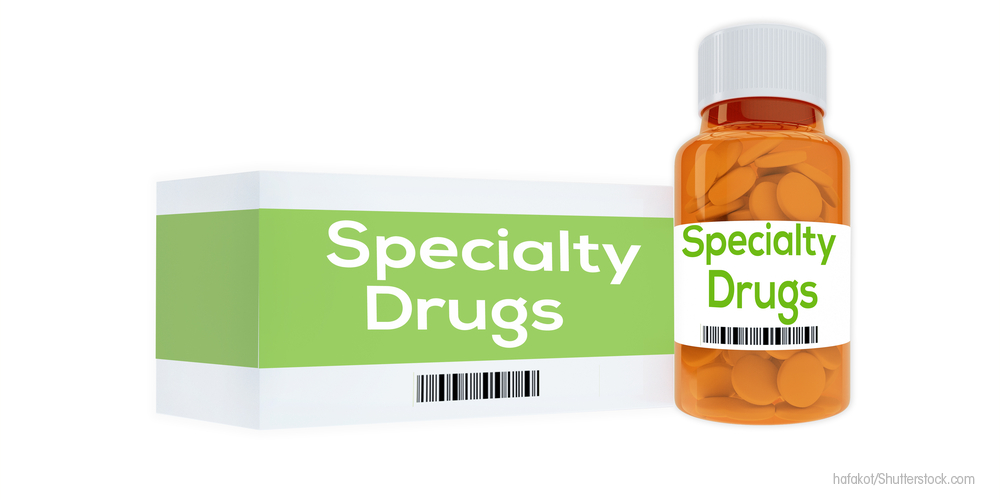The Promise of Specialty Drugs
What the future of specialty drugs holds for healthcare.

Generic and biosimilar competition is emerging in the specialty category, representing opportunities for savings for payers, according to Aimee Tharaldson, PharmD, senior clinical consultant, Emerging Therapeutics at Express Scripts.
In 2018, specialty drugs accounted for nearly half of drug spending for employer-funded plans, according to Tharaldson’s March 26, 2019 presentation “Specialty Pharmaceuticals in Development” at the Academy of Managed Care and Specialty Pharmacy Annual Meeting 2019 in San Diego.
“Understanding the pipeline of drugs in this space is critical for payers so they can prepare and create a sustainable pharmacy benefit for members,” she said. “Specialty drugs are typically high-cost medications with special handling and storage requirements (i.e., biologic therapies) that treat chronic and complex conditions such as multiple sclerosis, cancer, rheumatoid arthritis (RA), and rare diseases.”
Related article: Top 9 Most Exciting Drugs in the 2019 Pipeline
In the past four years, a number of specialty drug generic options have been approved, representing $14 billion in overall U.S. spending opportunities, with the potential for $24 billion in expected specialty generics in the next five years, according to Tharaldson.
Through 2023, 71 biologic drugs will have lost patent protection, representing a $55 billion biosimilar market opportunity.
“The biosimilar market keeps growing with as many as nine more agents that could receive FDA approval by the end of this year,” she said
In addition, the orphan drug pipeline is experiencing significant growth, and account for 53% of all current specialty drugs in the approval pipeline.
In the first quarter of 2019, five specialty drugs have already been approved:
- Cablivi (caplacizumabâyhdp) for acquired thrombotic thrombocytopenic purpura
- Turoctocog alfa pegol (N8-GP) for hemophilia A
- Esketamine for depression
- Zulresso (brexanolone) for postpartum depression
- Mayzent (siponimod) for active secondary progressive multiple sclerosis (MS)
Tharaldson also called attention to the developing drug pipeline in several therapeutic categories that are of high interest to payers.
Inflammatory conditions
Inflammatory conditions are the leading therapy class based on per-member, per-year spending ($153 billion). The pipeline includes:
- Risankizumab, an interleukin (IL)â23 inhibitor for psoriasis (expected in 2019)
- Upadacitinib, a JAKâ1 inhibitor for RA (expected in 2019)
- A new indication for Stelara (ustekinumab), an ILâ12 and ILâ23 inhibitor, for the treatment ulcerative colitis (expected in 2019)
- Bimekizumab, an ILâ17A and â17F inhibitor for psoriasis (expected in 2020)
- Filgotinib, a JAKâ1 inhibitor for RA, ulcerative colitis, and Crohn’s disease (expected in 2020)
MS pipeline
Two MS drugs approved in March 2019. The first one, Mayzent (siponimod), a sphingosine 1âphosphate receptor modulator for secondary progressing MS, was approved March 26, 2019. The other, Mavenclad (cladribine) was approved March 29, 2019. It is a nucleoside analog that depletes B and T lymphocytes for relapsing MS (RMS).
In addition, there are also several MS drugs in development expecting approval in the next two years:
- Diroximel fumarate, a monomethyl fumarate prodrug for RMS (expected in 2019)
- Ozanimod, a sphingosine 1âphosphate receptor modulator for RMS (expected in 2020)
Oncology pipeline
Oncology therapies in developed that are projected to be approved in 2019 include:
- Erdafitinib, a pan-FGFR inhibitor, for urothelial cancer
- Quizartinib, an oral, selective FLT3 inhibitor, for acute myeloid leukemia
- Selinexor, an oral inhibitor of the XPO1 protein, for multiple myeloma
- Pexidartinib, a selective tyrosine kinase inhibitor of CSF-1 receptor, KIT and FLT3 internal tandem duplication, for tenosynovial giant cell tumor
- Entrectinib, a potent small-molecule tyrosine kinase inhibitor, for NTRKâfusion+ solid tumors
- Polatuzumab, an antibody-drug conjugate that targets the CD79b protein, for diffuse large B-cell lymphoma
- Darolutamide, a non-steroidal androgen receptor antagonist, for prostate cancer
- Fedratinib, an oral kinase inhibitor, for myelofibrosis
Tharaldson touched on other important pipeline categories to watch, including:
- Nonalcoholic steatohepatitis (NASH). “The pipeline for 2020 and beyond is extensive, with many phase 2and phase 3 drugs in development,” she said. “Current treatment options are limited for this condition; most recommendations for treatment are focused on weight, diet, and exercise. However, these new treatment options come with many unknowns, including a steep projected price of $3,000 to $70,000 per year.”
- Alzheimer’s disease. Although there are drugs in development for treating Alzheimer’s disease, this is a high risk/high reward category plagued with many late-stage failures, according to Tharaldson. “The next wave of products, if successful, could potentially reach the market in 2021 at the earliest. Since it is a disease impacting over 5 million Americans, a disease-modifying drug that is shown to be safe and effective and receives FDA approval would be a blockbuster drug.”
- Hemophilia. Several therapies are in development for treating hemophilia, which could result in approvals between 2020 and 2022, including several gene therapies.
David Calabrese of OptumRx Talks New Role, Market Insulin Prices and Other Topics 'On His Mind'
April 13th 2023In this month’s episode of the "What's On Your Mind podcast," Peter Wehrwein, managing editor of MHE connects with the now Chief Clinical Officer of OptumRx Integrated Pharmacies, David Calabrese. In this conversation, David touches on his transition in January as OptumRx’s former chief pharmacy officer and market president of health plans and PBMs to his new role as Chief Clinical Officer where he now focuses more on things such as specialty pharmacy to home delivery — with an overall goal of creating whole-patient care. Throughout the conversation, Calabrese also touched on the market’s hot topic of insulin prices and behavioral health services within the OptumRx community, among other topics.
Listen
Briana Contreras, editor of Managed Healthcare Executive, spoke with Nancy Lurker, CEO and president of EyePoint Pharmaceuticals. Nancy shared a bit about EyePoint and how the organization’s innovative therapies are addressing patient needs through eye care, and most importantly, she addressed C-Suite positions like the CEO role. Nancy shared advice for those seeking to reach the CEO level, especially toward women in healthcare and other roles, and what it takes to run a biopharma company.
Listen